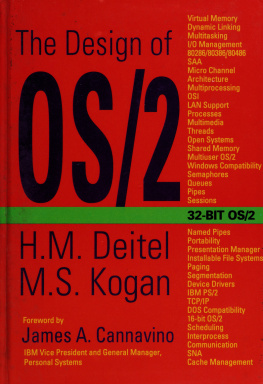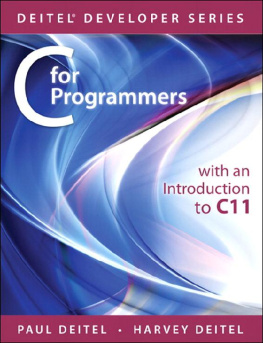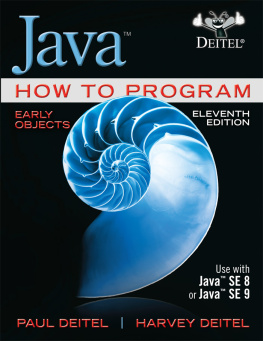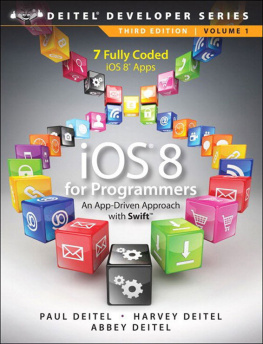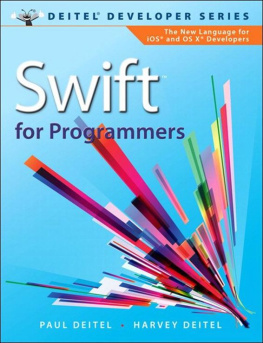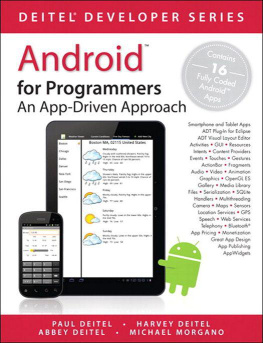Deitel - The design of OS/2
Here you can read online Deitel - The design of OS/2 full text of the book (entire story) in english for free. Download pdf and epub, get meaning, cover and reviews about this ebook. year: 1992, publisher: Reading, Mass. : Addison-Wesley, genre: Computer. Description of the work, (preface) as well as reviews are available. Best literature library LitArk.com created for fans of good reading and offers a wide selection of genres:
Romance novel
Science fiction
Adventure
Detective
Science
History
Home and family
Prose
Art
Politics
Computer
Non-fiction
Religion
Business
Children
Humor
Choose a favorite category and find really read worthwhile books. Enjoy immersion in the world of imagination, feel the emotions of the characters or learn something new for yourself, make an fascinating discovery.
The design of OS/2: summary, description and annotation
We offer to read an annotation, description, summary or preface (depends on what the author of the book "The design of OS/2" wrote himself). If you haven't found the necessary information about the book — write in the comments, we will try to find it.
The design of OS/2 — read online for free the complete book (whole text) full work
Below is the text of the book, divided by pages. System saving the place of the last page read, allows you to conveniently read the book "The design of OS/2" online for free, without having to search again every time where you left off. Put a bookmark, and you can go to the page where you finished reading at any time.
Font size:
Interval:
Bookmark:

None
Deitel, Harvey M., 1945
None
This book was produced in EPUB format by the Internet Archive.
The book pages were scanned and converted to EPUB format automatically. This process relies on optical character recognition, and is somewhat susceptible to errors. The book may not offer the correct reading sequence, and there may be weird characters, non-words, and incorrect guesses at structure. Some page numbers and headers or footers may remain from the scanned page. The process which identifies images might have found stray marks on the page which are not actually images from the book. The hidden page numbering which may be available to your ereader corresponds to the numbered pages in the print edition, but is not an exact match; page numbers will increment at the same rate as the corresponding print edition, but we may have started numbering before the print book's visible page numbers. The Internet Archive is working to improve the scanning process and resulting books, but in the meantime, we hope that this book will be useful to you.
The Internet Archive was founded in 1996 to build an Internet library and to promote universal access to all knowledge. The Archive's purposes include offering permanent access for researchers, historians, scholars, people with disabilities, and the general public to historical collections that exist in digital format. The Internet Archive includes texts, audio, moving images, and software as well as archived web pages, and provides specialized services for information access for the blind and other persons with disabilities.
Created with abbyy2epub (v.1.7.0)




'

Virtual MemoryDynamic LinkingMultitaskingI/O Management8Q286/80386/80486SAA
Micro ChannelArchitectureMultiprocessingOSI
LAN SupportProcessesMultimediaThreadsOpen SystemsShared MemoryMultiuser OS/2Windows CompatibilitySemaphores
Dsiphpq
1JLU %S U wd
Pipes
Sessions
Foreword by
IBM Vice President and General Manager,Personal Systems
Named PipesPortability
Presentation ManagerInstallable File SystemsPaging
SegmentationDevice DriversIBM PS/2TCP/IP
DOS Compatibility
16-bit OS/2
Scheduling
Interprocess
Communication
SNA
Cache Management

f
p
To the designers, implementors, and testers of OS/2:
For bringing edge-of-the-art distributed computingcapabilities to the desktop of the 1990s
To Dean Edward Simco:
For his indefatigable efforts in creating and nurturing theCenter for Computer and Information Sciences at Nova University
Digitized by the Internet Archivein 2018 with funding fromKahle/Austin Foundation
https://archive.org/details/designofos20000deit
It is a pleasure to write these opening comments for Deitel and Kogans, The Design ofOS/2. We at IBM believe strongly that the new 32-bit OS/2 2.0 will have an importantplace in the market for personal computers, workstations, and network servers. The bookclearly and thoroughly explains the architecture of the operating system in a manner appropriate both for technical professionals who want to understand OS/2s internal structure, and for software developers considering investing in OS/2 applicationsdevelopment. It provides insights into why various key design decisions were made.
Dr. Michael Kogan is the chief architect of OS/2 2.0; Dr. Harvey Deitel is the authorof one of the worlds most widely used operating systems textbooks. Their combinedexperience covers every major current IBM operating system, as well as the UNIX system, networking, multimedia, and open systems. Dr. Kogan, through his position at IBM,is well apprised of IBM architectural trends. Dr. Deitel consults in the open systems arenawith activities related to open operating systems, object orientation, OSI protocols, andinternational computing and communications standards.
Why OS/2?
Computer systems are evolving rapidly, and OS/2 is designed to support these changes.There are radical changes in hardware, from older systems supported by modest 8- or16-bit microprocessors, to newer high-powered 32-bit microprocessors such as the Intel80386 and 80486. RISC systems and multiprocessing systems offer the potential formassive increases in net processing power.
Radical changes in user support also are demanded. The personal computers of theearly to mid-1980s tended to be standalone systems. In the 1990s, personal computerswill be networked in local and wide area networks. OS/2 is designed to support mission-critical applicationsthat is, applications that must function continuously and reliablyto support key activities of businesses and other organizations. OS/2 is designed to enhance personal productivity. End users working in OS/2 environments can get moredone because of the ease of use, high performance, high reliability, information accessibility, and system integrity provided by OS/2.
VI
Foreword
The shift in application development toward object-orientation is gaining momentum. To become more productive software developers need to reuse components, to develop prototypes more rapidly, and to implement polished and tuned applications faster.OS/2 provides an environment conducive to object-oriented systems development.
The following sections briefly describe OS/2 2.0 and its capabilities. As you readthis book, you will come to understand what is under the hood, and how these capabilities are implemented.
The Integration Platform
We call OS/2 2.0 the integration platform because you can run your existing DOSapplications, DOS extender (such as the popular Windows) applications, and OS/2 1.3applications on OS/2 2.0, and they will run more efficiently on the same hardware thanthey do under their originally intended operating systems. You can also run the new,high-performance 32-bit applications designed to take advantage of 32-bit architectures.Applications run better from the standpoint of performance, integrity, and usability,translating into productivity gains.
Protected Multitasking
OS/2 2.0 represents the evolution of DOS into the world of protected multitasking. Ituses the protection mechanisms of the 80386/80486 architecture to ensure robust operation. It runs many applications simultaneously without the danger of misbehaved applications destroying one another or the operating systemprecisely what is needed inmission-critical application environments. An application may not access the privatedata of other applications. This level of protection is facilitated by the fact that OS/2applications execute in separate address spaces; DOS extender applications, on the otherhand, share a single address space. An errant DOS application may destroy a DOSextenders kernel, thus requiring a reboot, and work may be lost; the OS/2 kernel is protected from errant applications. OS/2 can run multiple versions of the same softwaresimultaneously, making it ideal as an application developers platform. Its multitaskingcapabilities make it appropriate as a network server. It uses preemptive scheduling, so itoffers good responsiveness to applications of differing characteristics. Priorities are calculated dynamically, so OS/2 can multitask timing-critical applications in both the foreground and the background.
Next pageFont size:
Interval:
Bookmark:
Similar books «The design of OS/2»
Look at similar books to The design of OS/2. We have selected literature similar in name and meaning in the hope of providing readers with more options to find new, interesting, not yet read works.
Discussion, reviews of the book The design of OS/2 and just readers' own opinions. Leave your comments, write what you think about the work, its meaning or the main characters. Specify what exactly you liked and what you didn't like, and why you think so.

